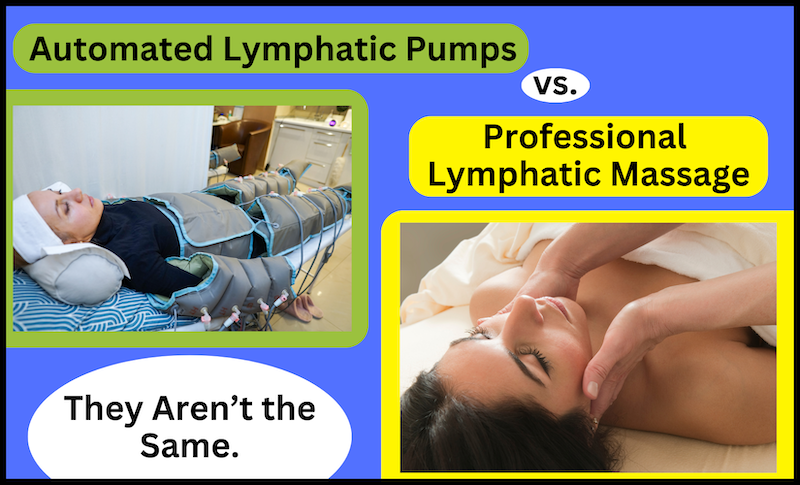Pneumatic Lymphatic Pump Machines:
Not a Substitute for Lymphatic Massage

In recent years, various lymphatic drainage pump machines, such as the Ballancer Pro, Lymphapress, Flowpresso, and Flexitouch, have gained popularity as at-home self-management tools for people with a condition known as lymphedema. As these pneumatic pumps gained recognition, high-end spas began purchasing them and offering them to their members. Do they really help? Are spas just trying to get around paying a highly trained therapist to do lymphatic massage? What are the pros and cons of using a pump vs. getting manual lymphatic massage?
In deciding how to spend your hard earned dollars for lymphatic therapy, it’s essential to understand that there are significant differences between these machines and skilled Manual Lymphatic Drainage (MLD) performed by a licensed therapist trained through an accredited school.
Lymphatic Drainage Pump Machines
Lymphatic drainage pump machines are designed to aid individuals with lymphedema in managing their condition at home. These machines typically consist of inflatable garments, such as sleeves or boots, which are connected to a pump. The pump inflates the garments, applying pressure to different parts of the body to stimulate lymphatic flow. While these devices can offer at-home benefits for people who are managing true lymphedema, they come with several important considerations when they are offered by spas as a substitute for a trained therapist.
Quality Matters
Not all lymphatic drainage pump machines are created equal. High-quality devices are calibrated to provide controlled and directional pressure, effectively encouraging lymphatic fluid movement. Unfortunately, not all machines sold online, particularly on platforms like Amazon, undergo rigorous testing and regulation. Some subpar devices merely squeeze the body without ensuring that lymph flows in the right direction. The improper application of pressure can potentially send lymphatic fluid in the wrong direction or, in severe cases, lead to lymphatic injury, causing further harm to individuals with significant swelling.
Pumps Are an Aid, Not a Substitute for Skilled Manual Therapy
Even when using a high-quality lymphatic drainage pump as part of the overall lymphedema treatment plan, it is essential for individuals with lymphedema to maintain regular lymphatic drainage massage with a Certified Lymphedema Therapist. These therapists possess a deep understanding of the lymphatic system and their skills far exceed what can be done by a machine. Lymphatic pumps are not a substitute for a skilled lymphatic therapist, but don’t take my word for it – read this University of Michigan School of Medicine compression pump information sheet for patients that says exactly that.
Problems Caused by Pumps
One of the primary issues associated with pneumatic pump lymphatic machines is patient discomfort. The pressure exerted by these devices can be intense, and some individuals may find the experience uncomfortable or even painful, especially if the pressure is not properly adjusted to suit their tolerance levels. This discomfort can lead to non-compliance, as patients may be reluctant to use the machine regularly, impacting its effectiveness.
Another challenge is the potential for skin irritation and damage. If the device’s cuffs or sleeves are not appropriately sized, positioned, or maintained, they can cause pressure sores, blisters, or chafing on the skin. Proper fit and regular inspection are crucial to minimize this risk.
Repeated use of pumps without regular manual therapy often leads to the creation of a cuff of fibrotic tissue where arm and leg sleeves end. Even though many manufacturers have tried to create garments for the torso that overlap the arm and leg sleeves, permanent hard cuffs still form where the sleeves end. If these hard areas do not get addressed regularly, then they can create a blockade for the movement of lymphatic fluid past that point, trapping fluid in the affected limb.
Additionally, there can be difficulties in finding the right balance of pressure and cycle settings. Adjusting the machine to match an individual patient’s needs can be a complex task, and healthcare professionals need to ensure that the settings are suitable to provide therapeutic benefits while minimizing discomfort and potential side effects. Moreover, not all patients may respond well to pneumatic pump therapy, and it may not be the most appropriate treatment for everyone. As a therapist who regularly sees people for hands-on lymphatic therapy, I can state that many of my clients have stated that pumps actually worsened their condition. While this is not true for everyone, it certainly can happen. Please, if you have lymphedema, don’t simply buy a pump online or go to a spa for “lymphatic therapy” where the personnel are not properly trained in lymphedema therapy. You would be doing yourself a great disservice, particularly if you have an infection. Spa staff are not trained to spot or diagnose infections and using a pump while you have an active infection could land you in the hospital with sepsis – a potentially deadly infection – because the pump moved the infection to the bloodstream.
Manual Lymphatic Drainage (Lymphatic Massage)
by Licensed Therapists
Manual Lymphatic Drainage (MLD), commonly referred to as “lymphatic massage” is a specialized skin stretching technique that draws fluid into the lymphatic vessels and transports it to the bloodstream where it is peed out of the body. MLD involves gentle, rhythmic movements performed with the hands, creating a wave-like effect that encourages the natural movement of lymphatic fluid within the body. Lymphatic massage should always be administered by licensed therapists who have undergone accredited training programs such as at KLOSE or Norton Lymphatic Schools.
Skilled Certified Lymphedema Therapists have an in-depth knowledge of the lymphatic system and can tailor their techniques to each patient’s unique needs. This is especially important if someone has lymphedema, a chronic condition characterized by the accumulation of lymphatic fluid in the body’s tissues, that can be challenging to manage. The condition often requires ongoing treatment to alleviate symptoms and improve the patient’s quality of life.
Advantages of Hands-On “Lymphatic Massage” (MLD)
-
Precise and Targeted: Skilled therapists can accurately target specific areas where lymphatic flow may be compromised, ensuring that the treatment is personalized to the patient’s condition. No matter how fancy or advanced a robotic pump is, it is no substitute for the perception of the hands of an educated and experienced lymphatic therapist.
-
Safe and Gentle: MLD is a gentle and non-invasive technique that minimizes the risk of injury, making it suitable for individuals with varying degrees of lymphedema.
-
Comprehensive Assessment: Therapists can conduct a thorough assessment to identify the root causes of lymphedema and develop a customized treatment plan that may include lifestyle recommendations and MLD sessions.
-
Human Touch and Expertise: The human touch aspect of MLD fosters a sense of comfort and trust between the therapist and the patient. The therapist’s expertise and ability to adjust the treatment in real-time based on the patient’s feedback are invaluable.
Why MLD Should Be the Primary Approach
It’s crucial for individuals to remain vigilant and not be misled into thinking that machine-assisted therapy is superior to MLD. It is only good as an additive therapy to a routine of Manual Lymphatic Drainage by a qualified therapist, continuous compression, good skin hygiene, and appropriate exercise.
While lymphatic drainage pump machines can be useful tools for at-home management of lymphedema, they should not be considered a substitute for professional Manual Lymphatic Drainage performed by a certified therapist. Some spas offer pneumatic lymphatic pump machines as part of their services and charge substantial fees for their use. This should never be done for people with diagnosed lymphedema. Only medical professionals specializing in lymphatic therapy and Certified Lymphedema Therapists should supervise this type of therapy.
Make Sure Your Therapist is a Certified Lymphedema Therapist,
NOT a Massage Therapist who offers “Lymphatic Massage”
Verifying your therapist’s credentials is also essential; only Certified Lymphedema Therapists have the necessary training and expertise to provide effective MLD. Massage therapists who are not Certified Lymphedema Therapists (a completely separate discipline) are underqualified to perform Manual Lymphatic Drainage on people with lymphedema. Reputable lymphedema therapists should have their certifications available on their website so you can verify that the therapist really holds the credentials they claim. You can view Shannon’s credentials here.



